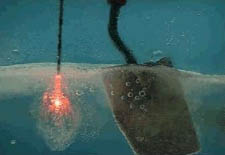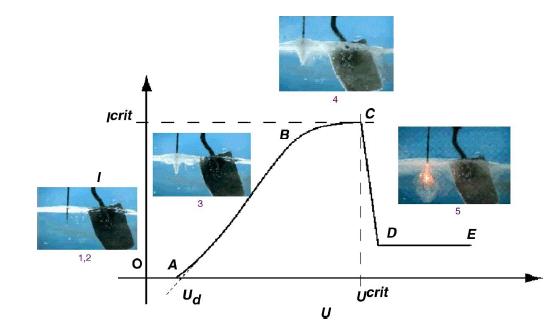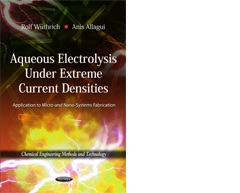Gas Evolving Electrodes Under Extreme Current Densities

|
When operated under high current densities (typically larger than 1 A/mm2), gas bubbles grow dense enough on an electrode to allow the formation of a thin gas film by bubble coalescence. Electrical discharges take place between the electrode and the electrolyte.
This effect is known in the literature under various names, such a electrode effects, electrochemical discharges or glow discharge electrolysis. It was first described in 1844 by the French physicists Foucault and Fizeau.
Formation of a Gas Film Around an Electrode

|
With increasing current density, more and more bubbles grow on the electrode surface eventually coalescing and forming a thin gas film (region C-D in the figure). We developed theoretical models predicting the minimal current density and cell terminal voltage needed in order to form the gas film.
Current Research
Our current research focuses on the following aspects:- Experimental study of the gas film stability and dynamics
- Experimental study of the hydrodynamic flow around the electrode
- Developing theoretical models of the phenomenon
The gas film stability, in particular its average life-time, is of particular interest for several applications of electrochemical discharges. We developed several methods to measure the gas film life-time under various conditions based on the analysis of the current signal during the process. Of particular interest is to answer the question how the average gas-film life time can be influenced (reduced or increased).
Our approach of the problem is to consider the phenomenon as a stochastic process. The main idea is to describe the onset of the effects as a phase transition. Our model, using percolation theory, predicts the current-voltage characteristics and the conditions of the onset of the electrodes effects as well as the critical voltage, the critical current density and the critical resistance.
- R. Wüthrich, Ch. Comninellis, H. Bleuler: Electrochimica Acta (2005) 50, 5242-5246
- A. Allagui, R. Wüthrich: Electrochimica Acta (2009) 54, 5336-5343
- R. El-Haddad, R. Wüthrich: Journal of Applied Electrochemistry (2010) 40, 1853-1858
Applications
Electrochemical discharges have applications in
- Micro-machining
- Synthesis of metallic nano-particles
- Surface treatments

